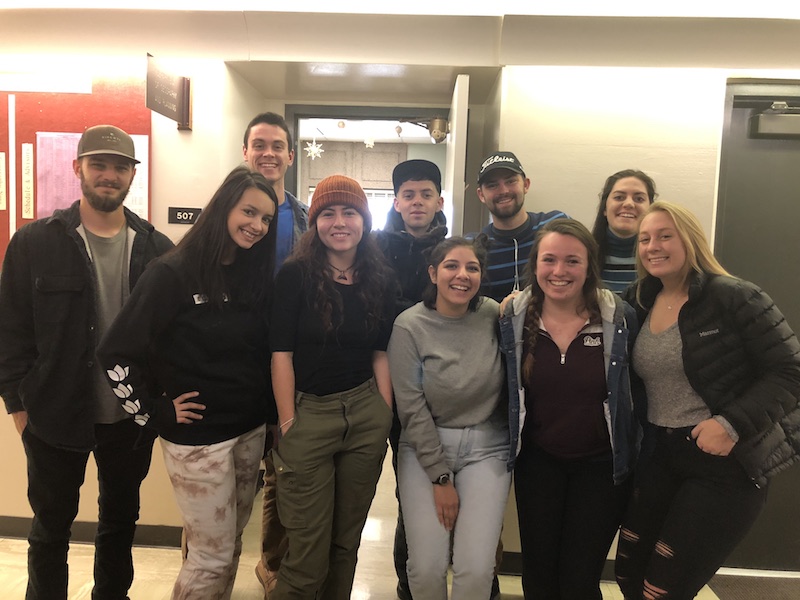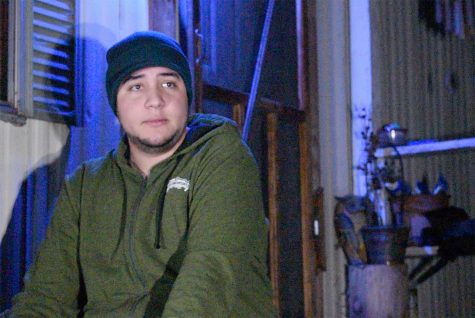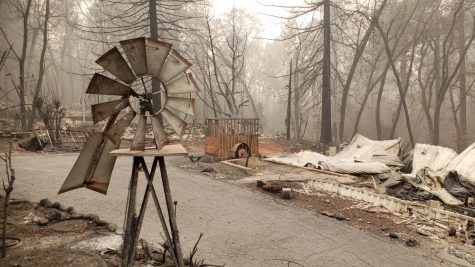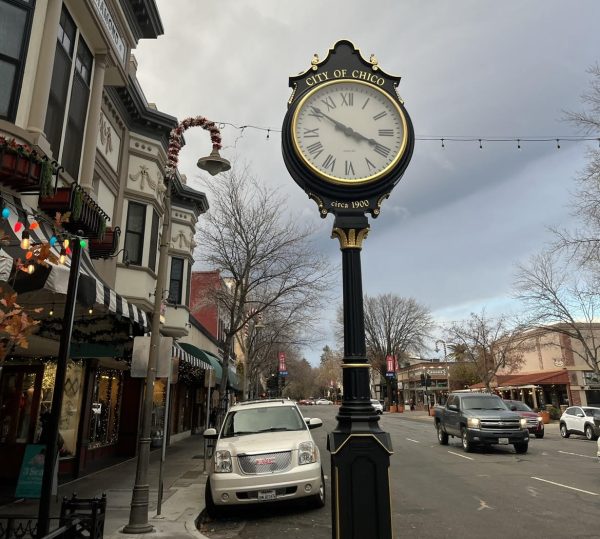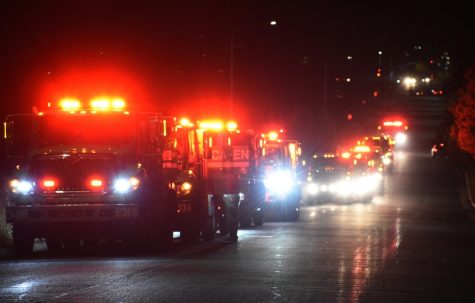New physical science building to use fossil fuels; students criticize campus
Students from Mark Stemen’s environmental thought in action class spoke out in frustration with the campus and planned changes to construction of the Siskyou II building in a conversation with The Orion. Photo credit: Natalie Hanson
The next Chico State building project planned for construction will use a gas-powered energy plan.
President Gayle Hutchinson revealed the plans for the new building, currently referred to as Siskiyou II, earlier this month.
Construction of the structure will require demolishing Siskiyou Hall and revamping the area behind Meriam Library. The 110,200-square-foot building will cost an estimated $101 million and is planned for completion by fall of 2020.
Hutchinson did not address that the new building will use an energy plan relying on gas, not electricity.
Some students and faculty have spoken out against the use of fossil fuels to power the new building and they aim to make the energy plan a campus-wide discussion.
Mark Stemen, a professor in geography and planning, mentioned two examples of promises made by the campus for climate neutrality. Chico State was one of the first schools in the country to commit to “climate neutral” changes, according to a news release, provided by Stemen, from Jan. 16, 2007.
Paul Zingg, president of Chico State at the time, signed the American College & University Presidents’ Climate Commitment. The agreement stated that campuses would have plans of action by 2009 to address their greenhouse emissions. This agreement also acknowledged a focus on reducing contributions to global warming.
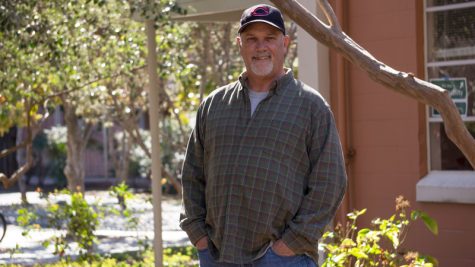
The preliminary plans for the new building focus on the importance of energy use intensity and predicted carbon emissions, according to a news release also provided by Stemen.
The plans show that use of electricity for the building was far more conductive to sustainability goals than to adopt a gas plan. This demonstrates that the design of the building has moved away from promises for environmental progress, according to Stemen.
Students enrolled in Stemen’s “Environmental Thought in Action” class expressed their frustration at the change of plans to a less sustainable, cheaper option.
“When we first started this push, everyone was really passionate about it, but we’ve lost that over the years,” said Ethan Dilley, a student enrolled in the class.
“I think the campus is too willing to move forward quickly with things without taking into consideration what students want or even looking at other options,” Dilley said. “I think we need to take a step back and plan things out.”

Maggie Scarpa, Associated Students’ commissioner of sustainability affairs, agreed.
“I feel like we’re all talk and no action,” she said.
“We have a climate action plan, but it doesn’t talk about how we’re going to reach climate neutrality… we say that we’re going to reach (it) by 2037 but there’s no plans for that,” Scarpa said. “How are we going to get there when we’re building with infrastructure that’s (powered by) fossil fuel?”
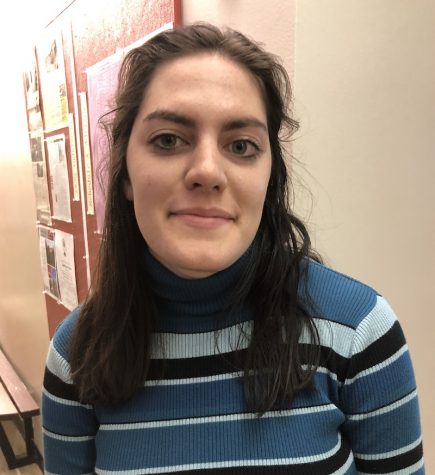
Student Natalie Kinney believes there’s a lack of transparency with students as this plan change took her by surprise.
“They posted on the website about it, how pretty it is and look how it’s going to help with the campus, but it doesn’t help know whether it’s going to be sustainable,” she said.

As a response, Stemen’s students are committed to rewording the Keep the Climate Commitment Initiative.
This initiative is based on the 2007 ACUPCC agreement and proposes that A.S. advise Chico State to fulfill the agreement’s promises with the construction of Siskyou II. Several students, including Dilley and Kinney, attended a meeting with A.S. officers and several administrators to get the change approved.
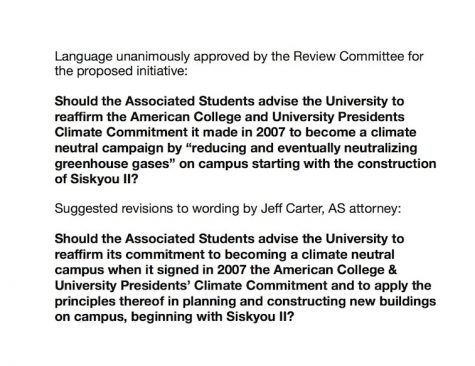
The vote to change the proposal’s wording passed, but representatives of the university were unanimous in their votes against it.
Dean of the College of Natural Sciences David Hassenzahl said that he saw nothing wrong with using gas to power Siskyou II. He claimed that there have been “many public opportunities” for community members to express their opinions and that sustainability “since day one” has been a priority.
“We’re using the money as best we can to meet some really important stretch goals for environmental well-being,” Hassenzahl said. “I actually think it’s meeting the expectations of the climate agreement as I understand it.”
However, others continue to disagree with his point of view.
“If other campuses can cut back, why not ours? It’s irresponsible and not a good model for our students,” said Sarah Pike, the department chair for comparative religion.
“We pride ourselves on our campus’ sustainability efforts,” Pike said. “This new building is a great opportunity to follow through on our ‘Today Decides Tomorrow’ motto for the better, not for the worse.”
To alumna Danielle Baxter, coordinator at Butte College’s sustainability resource center, this decision represents a long-term effect on the community of Chico.
“It’s important that we keep leaders accountable for what they say and what they commit to,” she said. “The city makes a lot of money on students coming from other areas all over the U.S. and a lot are attracted to Chico State’s natural assets and sustainability aspects.”
“If that’s a fraud, then (the city) isn’t holding the campus accountable and the university is not adhering to its stated values,” Baxter said.
In hopes to inform students and promote awareness, Stemen’s class will be tabling Monday and Wednesday in front of Siskyou from 10 a.m. to 2 p.m. They hope to obtain at least 500 signatures on their proposal and get the conversation spread across campus.
Natalie Hanson can be reached at [email protected] or @NatalieH_Orion on Twitter.




